

|
ACTIONS FOR PEACE
|
|
|
Around the Center:
Winter Soldier marches again--Amy Goodman on Common Dreams
- Chart: Where Your Income Tax Money Really Goes
Statement of Conscience Against War and Repression by the Board of the Peace/Life Center
Link: MoveOn--grassroots activism, electronically based
COMMUNITY CALENDAR --CURRENT & COMING EVENTS
Opinion and Letters to Connections
San Joaquin Connections--Our Sister Publication to the North, from the San Joaquin Peace and Justice Network
Community
Alliance--Our Sister Publication to the South--2008
issues (pdf)
National priorities Project: http://www.nationalpriorities.org/costofwar_home
Join us for a weekend in the Sierra with a stimulating group of
adults and young folks at Peace Camp on June 27-29 at Camp Peaceful Pines off
Hwy 108.
Saturday’s workshop is Israel, Palestine and the U.S., presented by Dan Onorato,
retired professor of English and Spanish at Modesto Junior College. Dan will
share what he learned from the peacemakers that he met during his trip to the
Middle East.
Sunday’s workshop is Youth Activism: Organizing across Generations. We will hear
from William Broderick-Villa, teacher and mayor of Waterford, who was elected to
the City Council at 24, and from Brianne Parmer, MJC student and advocate for
peace, gay rights and immigrant rights. Just added: Ruben Jo Mesta, youth media
activist, videographer and musician from Tracy.
Enjoy hiking, crafts, the star walk, the talent show, campfire, singing, the
mountains, creek and river, cool air, children’s activities and much-anticipated
food prepared by Deborah Roberts.
During last year’s camp, John Morearty said, “Now that I’m here, I can’t imagine
that I had considered not coming.” Come and we’ll all make a great weekend
together.
Send in your registration and we’ll save a place for you.
Click here for the
registration form. The cost for the whole weekend, including program,
food and lodging, is $70 for adults, $50 for youth. Register by June 8 and save
$10 a person.
WRITERS – If you have good writing skills, write an
article, up to 800 words, about peace, justice, or the environment and send it
to us. Local issues welcome. Email Jim Costello,
jcostello@igc.org
EDITORS - If you want to help us put out the paper, join us. Good
computer skills (preferably Word/Mac), good writing and editing skills
preferred.
DISTRIBUTORS - If you want to help us get the word out, contact Myrtle
Osner, 522-4967, osnerm@sbcglobal.net
Tim Dickinson from National Affairs posted up excerpts of a
recent interview between a TV reporter and chief justice Scalia:
STAHL: If someone’s in custody, as in Abu Ghraib, and they are brutalized, by a
law enforcement person — if you listen to the expression “cruel and unusual
punishment,” doesn’t that apply?
SCALIA: No. To the contrary. You think — Has anybody ever referred to torture as
punishment? I don’t think so.
STAHL: Well I think if you’re in custody, and you have a policeman who’s taken
you into custody–
SCALIA: And you say he’s punishing you? What’s he punishing you for? … When he’s
hurting you in order to get information from you, you wouldn’t say he’s
punishing you. What is he punishing you for?
In this interview Scalia also made the ticking-time-bomb argument. It is
disheartening to complement these morbid statements with those of the supposed
liberal Alan Dershowitz from an interview he had with Ken Roth on CNN Access
March 4, 2003:
“My basic point, though, is we should never under any circumstances allow
low-level people to administer torture. If torture is going to be administered
as a last resort in the ticking-bomb case, to save enormous numbers of lives, it
ought to be done openly, with accountability, with approval by the president of
the United States or by a Supreme Court Justice.”
Dershowitz assumes that a Supreme Court Justice, such as Scalia, can properly
mediate a proposed form of controlled torture! From my essay Torture is Never an
Option, I said:
“Ok, so what if a terrorist plants a nuclear bomb and will not tell
interrogators where it is? What if a sex-pervert-child-abductor will not tell
the whereabouts of a missing child he kidnapped? These extreme circumstances are
what most think about in terms of a ‘democratic society’ and acceptable use of
‘harsh interrogation tactics.’ The danger of this position is that the precedent
for legitimized state-run torture poses a far greater threat to the security of
its citizens. The potential terror of a terrorist bomb explosion is superceded
by the terror of thousands ‘disappearing’ into the night; never to be seen
again. The pain many support to be unleashed on a pedophile is superceded by
dungeons of rape on a mass scale.”
In other words, there has never been a political regime that has used
“controlled” or “moderate” torture. It could be argued that every government
views this practice as a necessity if needed for national security.
In the Turkish Press, President Raul Castro of Cuba stated in regards to
executing political criminals in his country, “We can't disarm ourselves before
an empire (United States) that doesn't stop harassing and attacking us." His
sentiments echo the logic of Scalia except his regime really does face down the
most powerful nation on the planet. Our government never stops telling us about
human-rights violations in other countries; and that leaders, such as Castro,
use US aggression as a ruse for an excuse to suppress democratic tendencies. As
these leaders watch our court justices and politicians use such rhetoric, we
must assume this hypocrisy reinforces their presumed need for state repression.
After the one terrorist attack on 9/11, the US government has acted as if our
democracy can be dismantled piecemeal to ward off the threats of more terrorism.
They also remind us of dangerous regimes that value totalitarianism in a world
that should be free. If Scalia can speak so lightly of Abu Graib due to one
terrorist attack on American soil, just imagine what he’d be like if there
existed 40,000 foreign enemy troops along our border: He would act no
differently than a North Korean official. The lesson we are learning is that
when more terrorism occurs in the United States, our government becomes more
tyrannical, and the greater the perceived threat, the greater the actual
tyranny.
Last week I bought a book titled An Essay on Crimes and Punishments by Cesare
Beccaria. John Adams had a 1775 copy of this work in English, and an original
Italian language edition in his personal library. In Chapter 16 he wrote on the
topic of torture saying:
The torture of a criminal during the course of his trial is a cruelty
consecrated by custom in most nations. It is used with an intent either to make
him confess his crime, or to explain some contradictions into which he had been
led during his examination, or discover his accomplices, or for some kind of
metaphysical and incomprehensible purgation of infamy, or, finally, in order to
discover other crimes of which he is not accused, but of which he may be guilty.
No man can be judged a criminal until he be found guilty; nor can society take
from him the public protection until it have been proved that he has violated
the conditions on which it was granted. What right, then, but that of power, can
authorize the punishment of a citizen so long as there remains any doubt of his
guilt? This dilemma is frequent. Either he is guilty, or not guilty. If guilty,
he should only suffer the punishment ordained by the laws, and torture becomes
useless, as his confession is unnecessary, if he be not guilty, you torture the
innocent; for, in the eye of the law, every man is innocent whose crime has not
been proved. Besides, it is confounding all relations to expect that a man
should be both the accuser and accused; and that pain should be the test of
truth, as if truth resided in the muscles and fibers of a wretch in torture. By
this method the robust will escape, and the feeble be condemned. These are the
inconveniences of this pretended test of truth, worthy only of a cannibal, and
which the Romans, in many respects barbarous, and whose savage virtue has been
too much admired, reserved for the slaves alone.
He then adds the most poignant fact about torture. “What is the political
intention of punishments? To terrify and be an example to others.” State
terrorism should be our greatest fear. Individual terrorists are, unfortunately,
occasional; but as a legislative norm terror becomes chronic and perpetual. This
was observed even by thinkers in the 18th century. The first page of this great
masterpiece has comments dedicated to the author by American admirers that
stated Beccaria, “saved America’s democracy from bigotry and stupidity—equally
as harmful as are seditious revolutions.” We hope he can save us from harmful
stupidity one more time.
By KEN SCHROEDER
This June 26th to 28th marks the twenty-sixth year that a group of peace minded folks will meet in the Sierras at Camp Peaceful Pines. As organizer Indira Clark remembers, “Peace Camp was organized by the Modesto Peace/Life Center to provide a weekend for families to meet for fellowship, relaxation, nature, and nurture – to get to know people more fully than just their politics.” The weekend will offer workshops, hiking, campfire, star walk, singing, talent show, children’s activities and delicious, healthy meals.
This year’s camp features Israel, Palestine and the U.S, a multi-media presentation by Dan Onorato, retired professor of English and Spanish at Modesto Junior College. Dan spent two weeks in Israel-Palestine in August 2005. His presentation features Israelis and Palestinians who are working courageously for peace and reconciliation. Dan traveled through the region with the Interfaith Peace Builders, an affiliate of the Fellowship of Reconciliation. His many years studying the conflict and his long history of nonviolent action make him uniquely qualified to give a perspective on this issue.
The workshop Youth Activism: Organizing across Generations will feature William Broderick-Villa and Brianne Parmer. William is the mayor of Waterford and a high school teacher. He attended Peace Camp as a child. At the age of 24 he was elected to the Waterford City Council. In August he will enter Georgetown University law school.
Brianne, a student at Modesto Junior College, has advocated for peace, for immigrant and gay rights. Brianne has been president of PRISM at MJC, where she has also been active in student government. As a child she also attended Peace Camp where, at the age of 12, she gave a presentation on the issue of a national missile defense system.
About Camp Peaceful Pines
At the 6,200-foot elevation in the Stanislaus National Forest on the Clark Fork of the Stanislaus River, Camp Peaceful Pines is located about 25 miles above Pinecrest off Hwy 108. Surrounded by tall peaks, the camp has a creek running through it. The morning brings a quality of sunlight found only in the Sierras and the night brings an awesome sky full of stars. The Clark Fork and Sunrise Rock, with views of the river valley, are short walks from camp.
The camp features kitchen and bathing facilities, rustic cabins and platform tents (unheated) and a cabin for those with special needs. Camp registration includes meals, lodging, and program. Partial financial aid and day-rates also available. Campers share in meal preparation, cleanup, and other work. Families and individuals are welcome.
Campers are welcome to arrive any time after 2:00 p.m. on Friday. The camp opens with supper on Friday and closes at noon on Sunday. Directions and other information will be mailed to participants before camp. Information: Ken Schroeder in Modesto, 209-526-2303 or Marilyn Dungan in Sonora, 209-533-3516. Early registration, before June 8th, entitles registrants to a $10.00 per person discount.
Peace Camp is organized by the Modesto Peace/Life Center in collaboration with Tuolumne County Citizens for Peace.
ACTION: Click here for the Peace Camp Flyer, Click here for a printable registration form and register!
Family Promise of Greater Modesto = Community Action for Homeless Families
By LYNN M. HANSEN, IHN Volunteer
Carefree warm May days bring families together for Mothers Day, graduations or other celebrations centered on family togetherness. This family picture is clouded for many families today, who are one paycheck away from financial ruin because of sudden job loss or a debilitating illness or who have been evicted because their rented home is in foreclosure. Without the safety net of an ample savings account, family or friends to assist, these families often find themselves fractured and homeless.
Although there are assistance programs available in our county, family members are separated for sleeping or sent to a motel for temporary living quarters. Families in these situations do not have the security of knowing that their food and housing is taken care of, so they can concentrate on looking for employment or save their money for first and last month deposits needed to acquire permanent housing.
What can a community do for families caught in such circumstances?
Family Promise, a 142-affiliate national organization (www.familypromise.org) offers a different and workable model of assistance to homeless families. Their mission focuses on providing a volunteer community support network to help homeless families regain independence.
In 2002 twelve dedicated people, believing that the family unit is essential to healthy communities, came together to develop such a network in Modesto. They recruited area churches as part of an interfaith hospitality support system to provide a homelike atmosphere for families in transition. The network of participating churches took three years to assemble and in 2005 a Family Promise affiliate opened in Modesto. Currently there are 10 churches and one support church (which provides volunteers only) involved with the Family Promise of Greater Modesto. It is truly an Interfaith Hospitality Network (IHN) funded by volunteer service, donations and grants.
Network churches open their facilities to house, feed and provide Overnight Hosts for up to a maximum of 4 families (or 14 people) safely for one week. Volunteers eat meals with the families, play games with the children, even tutor children needing extra help with school assignments. At the end of one week, families are sent on to another church in the network and continue weekly as needed for up to 60 days.
Laundry, shower facilities and Internet access needed for job searches, as well as case management of each family, are provided by the Family Promise Office Family Center. To qualify, families are screened by at least two interviews and agree to a criminal background check. They must be free of substance abuse and have no recent criminal record related to drug use, possession or violent crime; they cannot have an open child protective case or require protection from domestic violence. Job and income history, motivation and housing history are criteria used in the screening process.
Upon accepted into the program, each family is supervised by a Family Promise caseworker, who evaluates their progress toward achieving their goals, holds classes on life skills and provides connection with resources in our community for jobs, housing, counseling, or other needs. At 30 days the family is re-evaluated to determine its need to continue in the program. The average transition time is about 50 days.
The success of the Interfaith Hospitality Network in our community is due to the dedication of community volunteers, many of whom may have avoided homeless people, because they felt helpless and wilted under the enormity of the problem. Through Family Promise volunteers can be a small part of an effective network and as a group provide important assistance to families in need. Volunteers see the homeless family members as people very much like themselves, because the opportunity to share meals and talk with families helps to de-stigmatize homelessness. In return homeless families experience compassion, rather than judgment. It is truly satisfying work and makes a difference in the lives of others.
Although not all families succeed in their transition, Executive Director Sandra Franklin feels that contact with the network is a positive window none the less.
ACTION: Those interested in becoming an active part of the IHN in this area should consider the following list of ideas:
1. If you are pastor of a local church that is not part of the local IHN you are urged to discuss how your congregation can be involved.
2. Consider donating your expertise, i.e. cosmetology/barber to computer training or anything that might help families in need.
3. The Family Center staff is always looking for volunteer drivers.
4. Attend the Jeshua Franklin concert described in th following article.
To help with any of the above mentioned ideas or offer other services, contact Sandra Franklin, Executive Director of Family Promise of Greater Modesto at 209-549-9454 or by email at sfranklin_fped@hotmail.com or at The Office and Family Center, 2301 Woodland Ave, Suite 7 & 8, Modesto, CA 95358.
Jeshua Franklin concert to benefit Modesto’s Family Promise
By SANDRA FRANKLIN
Jeshua Franklin & Friends, accompanied by Dr. Yan Yan Chan on the piano, will perform on Friday, May 16 at 7:00 p.m. at the Modesto Christian Reformed Church, 2620 College Avenue, Modesto. Proceeds from this performance will benefit Family Promise of Greater Modesto! Family Promise is a non-profit organization that provides shelter to homeless families through a network of local congregations and volunteers.
Through this program, families can stay together while working on regaining their independence after the loss of a job, recovering from an expensive medical emergency or losing their place of residency. Your donations will help this network provide temporary shelter, food, transportation, case management and resource connections to the families in our program. [See accompanying article.]
Jeshua Franklin, a native of Modesto, currently serves as the Interim Director of Voice and Opera/Musical Theatre at Modesto Junior College. He holds a Bachelor of Arts degree in Flute Performance from Bethel College (Indiana), where he graduated Summa Cum Laude, and a Master of Music degree in Choral Conducting from Bowling Green State University (Ohio).Jeshua has played flute professionally with the Modesto Symphony Orchestra, Modesto Performing Arts, Townsend Opera Players, Vesper Chamber Orchestra, Camaraderie Woodwind Quintet and Serendipity Winds as well as numerous other pit orchestras. As a choir member, he has performed in Washington National Cathedral, Carnegie Hall, and the Rudolfinum in Prague. Jeshua also directs the Chancel Choir at Modesto’s First United Methodist Church, serves as a manager with the Modesto Symphony Youth Orchestra, and is a private teacher and freelance artist.
The performance will feature instrumental and vocal music from many styles and time periods. Guests will include students and faculty from Modesto Junior College and other musicians from the community. Come and enjoy an evening of good music and support the families in our program!
“Building a world without wars has been the greatest human ideal throughout history. Unfortunately, it has never been accomplished….The biggest gift adults can give children is to make public the complete history of and the different viewpoints about war, and to help them consider how we can realize the human ideal.”
-- Chiekio Akiyama
Japanese Radio Commentator
Preface, Faithful Elephants
11 Picture Books to Read with All Quiet on the Western Front
By GILLIAN WEGENER, Oakdale Junior High School
Stanislaus Connections readers may find the resources in this thoughtful article to be useful for family libraries, gifts, or in discussions of the impact of war and what makes for peace – Editors
Preface: These books are meant to provide an insight into a time and an event with which our students have little experience. The books that specifically deal with World War I provide excellent text and pictures to help give students the ability to accurately visualize what is happening in All Quiet on the Western Front.
In putting together this bibliography, however, it was difficult to find books specifically about WWI. This conflict goes largely untaught in junior highs/middle schools. Because the United States was actually involved in the war for only a year or so, WWI seems to have lapsed into the unconscious history that we carry around with us. It was interesting to look to other countries – Canada, England, and Australia – to find books that addressed this historical era. The dearth of WWI picture books also forced me to look for connections between All Quiet and other conflicts in other time periods. These books help to illustrate the universality of war, and it is my hope that by sharing all of these books with my students as we read All Quiet on the Western Front, they will be begin to see this universality and begin to understand that working toward peace is a calling that each of us must answer. — G.W.
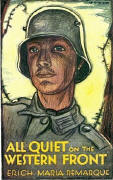 Last
year I taught Erich Maria Remarque’s All Quiet on the Western Front to my
8th grade honors class. I assumed they had little knowledge of World
War I as it is not usually part of history curriculum until high school. Their
history teacher was very helpful in giving them some background information, and
I brought in several books with pictures from the era and made those available
for the students. I thought some of the students might have some background
knowledge about World War I from movies or television, but it quickly became
clear that they had little to no prior knowledge about this major historic
event. Not only that, but they had little comprehension of the effects of
warfare on the psyche of the soldiers and civilians involved in war. While those
of us who have never experienced war can never thoroughly comprehend the reality
of war, we can strive to understand through the words and pictures available to
us through picture books. The picture books included here provide a picture of
war across time, place, and historic moment and were chosen to help students not
only be able to visualize the specifics of World War I, but also to help them to
empathize with the people who are caught in warfare’s maelstrom.
Last
year I taught Erich Maria Remarque’s All Quiet on the Western Front to my
8th grade honors class. I assumed they had little knowledge of World
War I as it is not usually part of history curriculum until high school. Their
history teacher was very helpful in giving them some background information, and
I brought in several books with pictures from the era and made those available
for the students. I thought some of the students might have some background
knowledge about World War I from movies or television, but it quickly became
clear that they had little to no prior knowledge about this major historic
event. Not only that, but they had little comprehension of the effects of
warfare on the psyche of the soldiers and civilians involved in war. While those
of us who have never experienced war can never thoroughly comprehend the reality
of war, we can strive to understand through the words and pictures available to
us through picture books. The picture books included here provide a picture of
war across time, place, and historic moment and were chosen to help students not
only be able to visualize the specifics of World War I, but also to help them to
empathize with the people who are caught in warfare’s maelstrom.
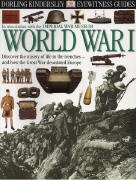 Adams, Simon. EYEWITNESS:
WORLD WAR I. New York: DK Publishing. 2004. 72p. ISBN 0-7566-0740-X. MS/YA;
Pictorial History.
Adams, Simon. EYEWITNESS:
WORLD WAR I. New York: DK Publishing. 2004. 72p. ISBN 0-7566-0740-X. MS/YA;
Pictorial History.
This book, one of the DK series of Eyewitness books, does not tell a specific story about The Great War. It does, however, give an essential overview of the players, equipment, significant battles, and assorted tales of this conflict that are essential for understanding a novel as embedded in historical fact as All Quiet on the Western Front. That may be because the photographs were taken in London’s Imperial War Museum and provide as realistic a portrait of life in the trenches as is possible for a modern audience. The photographs of the time do not flinch from the grim reality of the war and so are also essential for establishing context for young adult readers.
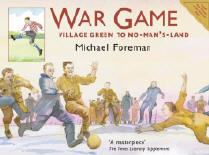 Foreman, Michael.
WAR GAME. London: Pavilion
Books Limited. 1997. 67p. ISBN 1-85793-713-9. MS/YA; Picture Book.
Foreman, Michael.
WAR GAME. London: Pavilion
Books Limited. 1997. 67p. ISBN 1-85793-713-9. MS/YA; Picture Book.
This long picture book, illustrated with delicate and moving watercolors, takes the reader from the very beginnings of England’s involvement in WWI as we follow four friends through their enlistment, engagement, and eventual death in the battlefield. The main event of the story is the story of the Christmas Truce of 1914, when German and British troops met in the pitted waste of ‘No Man’s Land’ to play soccer and celebrate the holidays. If this book needed to be shortened to fit into a single period, teachers could easily focus just on the Christmas Truce and the battle that follows, but the beginning of the novel, which focuses on the idealism with which new recruits approached the war, also mirrors the experiences found in All Quiet on the Western Front. The poignant conclusion relates closely to All Quiet and will provide a visual aspect to the story that students may not be able to manage on their own. Teachers may want to point out to students that the book is dedicated to the author’s four uncles, all of whom were lost during the Great War.
Granfield, Linda. IN FLANDERS FIELDS: THE STORY OF THE POEM BY JOHN MCCRAE. Illustrated by Janet Wilson. Ontario, Canada: Stoddart Kids. 1995. 29p. ISBN 0-7737-5925-5. MS/YA; Picture Book.
The core of this book is John McCrae’s famous poem “In Flanders Fields” written in May 1915. McCrae was a battlefield surgeon treating soldiers in some of the worst battles of this conflict. He died in France in January 1918, eleven months before the Armistice. The poem is lavishly illustrated line by line. One of the most moving paintings is of a mother collapsed on her son’s bed clutching the letter that must have brought news of her son’s death. Another illustrates a field hospital, which will be useful in helping students to visualize some scenes in All Quiet on the Western Front. Granfield intersperses the poem with a wartime biography of John McCrae and some essential background knowledge of the Great War. This book makes an excellent introduction to World War One, and gives students a window to understand the loyalty to the cause and the immense loss experienced by both those on the field and those on the homefront.
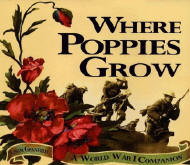 Granfield, Linda.
WHERE POPPIES GROW: A WORLD WAR I COMPANION.
Ontario, Canada: Fitzhenry &
Whiteside. 2001. 47p. ISBN 0-7737-3319-1. MS/YA; Historic Picture Book.
Granfield, Linda.
WHERE POPPIES GROW: A WORLD WAR I COMPANION.
Ontario, Canada: Fitzhenry &
Whiteside. 2001. 47p. ISBN 0-7737-3319-1. MS/YA; Historic Picture Book.
More of a historic overview than a story, Linda Granfield’s book is beautifully illustrated with photographs, posters, postcards, and propaganda of the time period. Each two page spread covers a different aspect of the war including the routines of soldiers, life on the homefront, the child’s perspective, spies, and the use of animals in battle. Though nearly all of the information is from an English or Canadian perspective, a discussion involving propaganda might show how soldiers and civilians on both sides were influenced by the media of the time, making this especially useful when reading All Quiet on the Western Front.
Heide, Florence Parry and Judith Heide Gilliland. SAMI AND THE TIME OF THE TROUBLES. Illustrated by Ted Lewin. New York: Clarion Books. 1992. 33p. ISBN 0-395-55964-2. UE/MS/YA; Picture Book.
War is, unfortunately, not limited to some distant past. In this book, the authors, a mother-daughter team, tell the story of Sami, a boy living through the devastating war in Lebanon during the late 20th century. Sami and his family take shelter in the basement during the repeated bombings of Beirut where Sami listens to his grandfather tell stories of the past and of hope for the future. It is important that students understand that war affects more than the soldiers involved and the families left behind. There are also civilians whose lives are disrupted and sometimes ended simply because they are in the way of greater trials. While this story has little in common with All Quiet except for the universal misery of warfare, it makes an interesting companion to the novel. I plan to use this novel toward the end of All Quiet on the Western Front which ends on a devastating, hopeless note. The message in Sami is that there is always hope for a better future, and in our own times, this is a message that our students may need to hear.
Jorgensen, Norman. IN FLANDERS FIELDS. Illustrated by Brian Harrison Lever. Vancouver, Canada: Simply Read Books. 32p. ISBN 1-8949-6501-9. MS/YA; Picture Book.
An unnamed soldier walks into ‘No Man’s Land’ waving a white flag in order to free a trapped bird. This book takes the perspective of both English/Australian soldiers and German soldiers as they watch the events unfold. It is a moving testament to shared beauty and hope in a world turned upside down and refers both to the historic Christmas Truce and to John McCrae’s poem “In Flanders Fields.” The symbol of the bird plays a similar role in All Quiet on the Western Front though to a very different end, and the theme of a common humanity will tie in to the novel as well. The pen-and-ink drawings illustrating Jorgensen’s book are gorgeous, very personal and very compassionate and will provide students with yet another window into this troubled time in history.
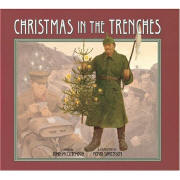 McCutcheon, John.
CHRISTMAS IN THE TRENCHES.
Illustrated by Henri Sorenson. Atlanta, Georgia: Peachtree Publishers. 32p.
2006. ISBN 1-56145-374-9. MS/YA. Picture Book.
McCutcheon, John.
CHRISTMAS IN THE TRENCHES.
Illustrated by Henri Sorenson. Atlanta, Georgia: Peachtree Publishers. 32p.
2006. ISBN 1-56145-374-9. MS/YA. Picture Book.
In 1984, noted folksinger John McCutcheon wrote a song called “Christmas in the Trenches.” Now he has adapted this song into a picture book with gorgeous oil paintings by Henri Sorenson, who also did the illustrations for The Yellow Star: The Legend of King Christian X of Denmark. As the title makes clear, this book also tells the story of the Christmas Truce of 1914. This time the story is told by a grandfather who fought in WWI to his grandchildren in answer to the question: “What was it like? Were you a hero?” This book comes with a CD that includes the story read by the author, the song that inspired the story, and “Silent Night” in English and German.
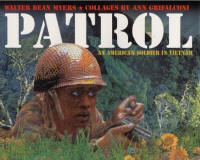 Myers, Walter Dean.
PATROL: AN AMERICAN SOLDIER IN VIETNAM.
Illustrated by Ann Grifalconi. New York: HarperCollins. 32p. 2004. ISBN
0-06-028363-7. MS/YA. Picture Book.
Myers, Walter Dean.
PATROL: AN AMERICAN SOLDIER IN VIETNAM.
Illustrated by Ann Grifalconi. New York: HarperCollins. 32p. 2004. ISBN
0-06-028363-7. MS/YA. Picture Book.
The protagonist of All Quiet on the Western Front is barely out of his teens. The same is true for the protagonist in Walter Dean Myers moving book of the Vietnam War. Myers has crafted a slow, almost languid poem of a young soldier’s experience of war. The accompanying collages represent the jagged, impressionistic landscape as seen by this soldier and provide an insight into the mind of someone thrust into terrifying reality. The connection between Paul and Myer’s youth is especially vivid when each of them encounters an individual ‘enemy’ and makes the frightening discovery that the ‘enemy’ is a lot like them.
Vietnam is perhaps as distant to many of our students as World War I, but this book helps make the connection between wars of different times and the sad similarities between them. Hopefully, our students will begin to see that the soldiers in these books are not so far different from them either.
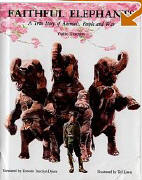 Tsuchiya, Yukio.
FAITHFUL ELEPHANTS: A TRUE STORY OF ELEPHANTS, PEOPLE AND WAR.
Translated by Tomoko Tsuchiya Dykes. Illustrated by Ted Lewin. Boston: Houghton
Mifflin Company. 1988. 29p. ISBN 0-395-46555-9. MS/YA. Picture Book.
Tsuchiya, Yukio.
FAITHFUL ELEPHANTS: A TRUE STORY OF ELEPHANTS, PEOPLE AND WAR.
Translated by Tomoko Tsuchiya Dykes. Illustrated by Ted Lewin. Boston: Houghton
Mifflin Company. 1988. 29p. ISBN 0-395-46555-9. MS/YA. Picture Book.
Many of our students show more compassion for animals than they do for each other. This picture book is sure to have an enormous impact on these students. Faithful Elephants is a true story from World War II Japan. The Tokyo zookeepers, worried that the zoo would be bombed and that the animals would then run amuck in the city, decide that they must put the animals down first. The elephants, loyal to the end, break the zookeepers’ hearts along with ours. World War I was the last war in which horses were used in battle, and there are several wrenching scenes of their destruction in All Quiet. Students who connect with animals may need a little heads-up concerning both these scenes in the novel and the story line of Faithful Elephants. The story is a must-read for any unit on the terrors and consequences of warfare, but a must-read with care.
Turner, Ann. DRUMMER BOY: MARCHING TO THE CIVIL WAR. Illustrated by Mark Hess. New York: HarperCollins. 29p. 1998. ISBN 0-06-027697-5. MS. Picture Book.
In All Quiet on the Western Front, the protagonist Paul Baumer returns on leave to his hometown where he confronts Herr Kantorek, the teacher who had urged him and many of his friends to join the war effort. Paul is angry with Kantorek who, with no real knowledge of war himself, has blindly urged young men to their deaths. The story in Drummer Boy is strikingly similar. It opens with a portrait of a boy, his smiling face wide open to the world. It ends with a portrait of the boy after he has seen battle, jaw set, eyes hard, and mind war-weary. The person he blames for his experiences will surprise you and your students and make an excellent jumping point for a discussion about idealism and hero worship and disillusion.
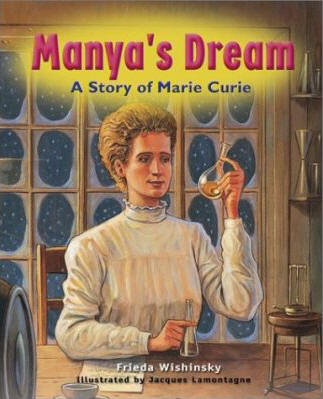 Wishinsky,
Frieda. MANYA’S DREAM: A STORY OF MARIE CURIE.
Illustrated by Jacques Lamontagne.
Toronto: Maple Tree Press, Inc. 2003. 29p. ISBN 1-894379-53-5. MS/YA. Pictorial
Biography.
Wishinsky,
Frieda. MANYA’S DREAM: A STORY OF MARIE CURIE.
Illustrated by Jacques Lamontagne.
Toronto: Maple Tree Press, Inc. 2003. 29p. ISBN 1-894379-53-5. MS/YA. Pictorial
Biography.
But where are the women of World War I? In searching for a book that represented women as active participants, I found Marie Curie, already a two-time Noble Prize winner, driving an ambulance during WWI in order to test out her brand-new X-ray equipment. Manya’s Dream is a biography of Marie Curie, and it is included here because it not only briefly discuss her involvement in WWI, but it gives a sense of Europe in the time in and around the war. This sense, both written and visual, is crucial so that students can grasp the effects of the war on a wider population. The book does not directly relate to All Quiet, but is one more layer of knowledge and understanding to give students as they read a complex novel about a generally unfamiliar topic.
Reprinted with permission of California Reader but edited for Connections.
Pssst, Buddy - $1 will getcha $17!
By ANN BRITTON
That is the Economics of Reading. “Dollars invested in ECD [early childhood development] yield extraordinary public returns.” The “Fed” has finally noticed what teachers, librarians and parents have known for a long time. The quote is from a report by Rob Grunewald and Arthur Rolnick of the Federal Reserve Bank of Minneapolis.* The report says, “Without support during these early years, a child is more likely to drop out of school, receive welfare benefits and commit crime.” In the long term the investment has a cost-benefit ratio of 1:17, they say.
One of the most effective investments is for parents to read to their children in the years before they enter school, starting as early as birth. It is the single most important activity in preparing children to learn to read and succeed in school. We have known that since the 1985 Becoming a Nation of Readers: Report of the Commission on Reading.
The recent economic downturn has put a crimp on public and private budgets resulting in fewer dollars for schools, libraries and personal pocketbooks of teachers and parents. Many schools are trying to run their reading programs without librarians. Teachers are trying their best to take up the slack.
Did you know that most of the classroom materials, like books other than textbooks, come out of teachers’ wallets, not the school budgets?
More books in the hands of more children; that is the goal. To help children, teachers, and parents do that, the Friends of the Modesto Library are offering a chance to make the most of money available.
From May 29 through June 1, 2008 they will host a sale of new children’s books from over 100 publishers – all for 50% off regular price! The Friends’ portion of the sale profits will be used for programs at the library. The volunteers who work the sale will earn books that are donated to library and literacy programs. The biggest return, however, will be the chance for teachers, parents and grandparents to find high quality, new books at exceptional bargain prices.
So, invest in a few books for a teacher to give to students in the classroom. Invest in time reading to that two-year old in your life. Invest in new books for a birthday, Christmas, Father’s Day, or an everyday present. Invest in a bag of books to send off on summer trips to the beach, or grandma’s, or camp.
As the Fed stated, “Helping our youngest children develop their life and learning skills results in better citizens and more productive workers.” Invest in the community. You can do it with books!
Sale Schedule
May 29 – June 1, 2008
10:00 am – 7 p.m. Thursday
10:00 am – 4 p.m. Friday & Saturday
12:00 pm – 4 p.m. Sunday
Sponsored by the Friends of the Modesto Library, 1500 I St., Modesto.
Flier at www.stanislauslibrary.org/about_friends_modesto.shtml, Info: 996-1531.
*A Proposal for Achieving High Returns on Early Childhood Development by Rob Grunewald and Arthur Rolnick, Federal Reserve Bank of Minneapolis. May 2005.

Tenth of each month. Submit peace, justice and environmentally friendly event notices to P.O. Box 134, Modesto, CA, 95353, or call 522-4967 or 575-4299, or email to Jim Costello. Free listings subject to space, availability and editing.
